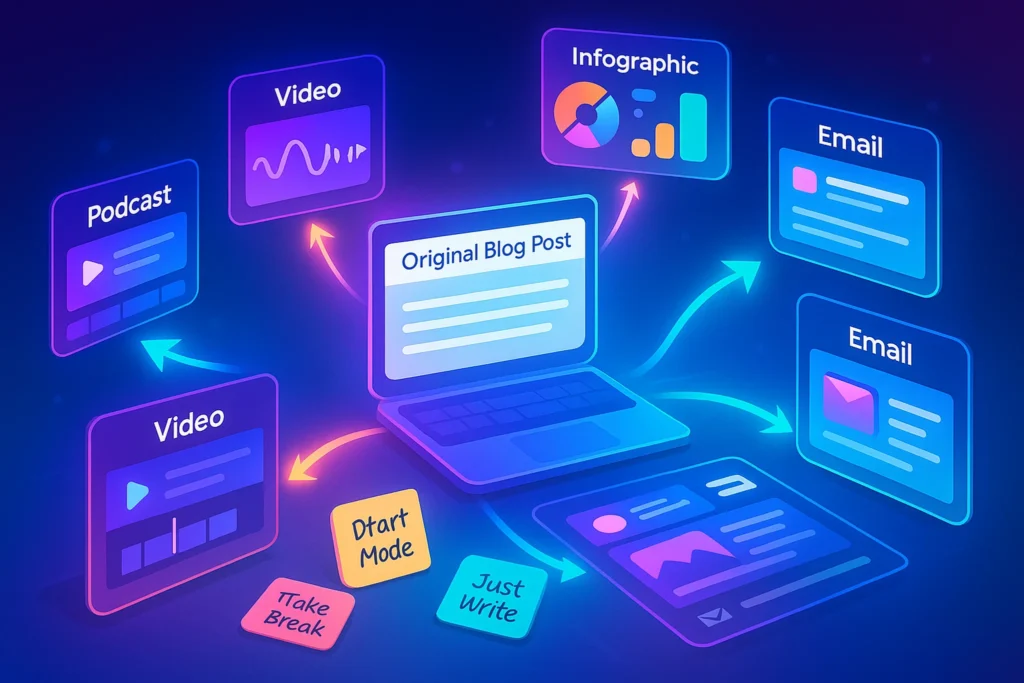-This post may contain affiliate links. If you click on one and make a purchase, I may earn a small commission at no extra cost to you.-
✍️ Introduction: One Blog, Endless Potential
You’ve written a blog post—maybe it took you hours, or even days. You hit publish. It’s out in the world.
And then… what?
Most content creators let their blog post sit idle, hoping for search traffic or sporadic shares. But in today’s attention economy, one piece of content should never equal just one format. Instead, your blog post can become a video, a podcast episode, an infographic, an email series, a Twitter thread—and more.
This is called content repurposing.
In this guide, we’ll show you how to turn a single blog post into five (or more) high-impact content pieces that stretch its reach, boost your SEO, and feed multiple platforms—without burning you out.
Let’s make your content work harder.
1. 🎥 Turn Your Blog @Post into a Video Script
Turning a blog into a video doesn’t mean reading it word-for-word on camera. It means extracting the most engaging parts and reshaping them into a visual flow. A well-repurposed video might include a quick intro hook (“Ever feel stuck growing your email list?”), 3–4 key takeaways from the post, and a clear CTA (“Read the full blog for advanced tips”).
Use pacing cues like pauses, transitions, or screen overlays to add visual rhythm. Platforms like Lumen5 and Pictory can even auto-convert blog text into animated video slides if you’re camera-shy.
This format also works beautifully for turning blog series into episodic content on YouTube or TikTok—expanding your content into serialized value.
Why it works:
People consume content differently. Some read. Others watch. Repurposing your blog into a video lets you tap into visual learners and boost engagement on YouTube, Instagram Reels, TikTok, and even LinkedIn.
How to do it:
-
Use your blog’s key sections (H2s) as the video outline.
-
Add intro hooks, calls to action, and a visual storyboard.
-
Record using tools like Loom, Tella, or Descript for polished narration and editing.
-
Upload to YouTube, embed the video back into your blog post to boost on-page metrics.
Real Example:
If your blog is titled “How to Start an Email List,” turn it into a 3-minute talking-head video explaining the first 3 steps—and link to the full post below. This works especially well with listicles or how-tos.
💡 Already using AI for content? Combine this with our Use ChatGPT to Write a Blog Post guide to quickly outline your video script from your existing blog content.
2. 🧠 Break It into Infographics or Visual Slides
Infographics don’t just summarize—they repackage insight visually for quicker absorption. Instead of repeating your blog post word-for-word, extract stats, quotes, step-by-step flows, or comparisons and reformat them into bite-sized visual blocks.
For example:
-
Turn a “5-Step Strategy” into a vertical process diagram
-
Use icons and color to illustrate pain points + solutions
-
Create a “before vs. after” transformation slide from your case studies
Infographics are also perfect lead magnets. You can gate them as downloadable PDFs or include them in toolkits to grow your email list—especially if your post is part of a broader content funnel.
Why it works:
Visual content performs incredibly well on platforms like Pinterest, Instagram, LinkedIn, and even in newsletters. A single graphic summarizing your blog post can dramatically increase shares and brand visibility.
How to do it:
-
Identify stats, key takeaways, or step-by-step sections in your post.
-
Use Canva, Visme, or Piktochart to design visuals.
-
Focus on visual simplicity: 1 idea per slide or infographic.
-
Share as a carousel post on LinkedIn or a Story highlight on Instagram.
Bonus Tip:
Save these graphics in a “Content Kit” folder—you’ll reuse them in emails, lead magnets, or even products.
Want to streamline this? Check out the tools we reviewed in Content Creation Tools for infographic-friendly platforms and visual AI helpers.
3. 🎙️ Repurpose It into a Podcast Episode
Podcasting isn’t just for interviews. You can create solo commentary episodes based on your blog posts—where you dive deeper into specific sections, tell related stories, or expand with new insights you didn’t include in the original post.
Even a 7–10 minute episode covering “the backstory” of your blog post (why you wrote it, how you applied it in real life) adds a new dimension for your audience.
Also, don’t underestimate the SEO and discoverability power of podcast show notes. Include relevant keywords and link back to the original blog, creating an ecosystem of content that reinforces itself.
Why it works:
Podcast listeners are high-intent audiences. By turning your blog into an audio experience, you gain a new channel while deepening your relationship with your audience.
How to do it:
-
Turn your blog into a loose script or talking points.
-
Record using Audacity, Descript, or even your phone with Anchor.
-
Add your commentary, personal anecdotes, or behind-the-scenes context.
-
Publish to Spotify, Apple Podcasts, and embed into your post.
Advanced Tip:
Use Descript’s Overdub feature to correct voice stumbles or add clarity without re-recording entire segments.
Already have a growing audience or email list? Repurposing into audio makes your blog feel alive. Learn how to grow and nurture that list in our AI Email List Guide.
4. 📬 Slice It into Email Series or Newsletters
When turning your blog into an email series, you’re not just breaking it apart—you’re curating the reader journey. Think about what a subscriber needs to know first, then what naturally comes next.
You might structure it like:
-
Email 1: Problem + teaser
-
Email 2: Core strategy (with CTA to full post)
-
Email 3: Common mistakes + personal insight
Don’t be afraid to trim or rewrite parts for clarity and brevity—email is a more personal, attention-sensitive format. And be sure to include a PS, a one-line follow-up question or suggestion, to keep the relationship warm and 2-way.
Bonus tip: If the blog post includes a tool list or tutorial, link to it directly inside the email using contextual phrases—not blunt hyperlinks.
Why it works:
Your email subscribers are your warmest audience. But that doesn’t mean they read your blog religiously. Repurposing your post into a 3-part email series keeps them engaged, even if they never visit your website.
How to do it:
-
Break the blog into 2–3 parts: intro/context, core strategy, actionable steps.
-
Add a subject line and preview text that teases curiosity.
-
Include a CTA linking back to the full blog or offering a related resource.
Optional Enhancer:
Add exclusive commentary or bonus tips in the email version to reward your list. And yes—you can write, format, and even A/B test these emails using tools from our AI Email List Guide.
5. 🧵 Reformat It for Social Media Threads and Posts
Great repurposing means reframing ideas for the scrollable world. Each platform has its native rhythm, and your blog’s content needs to match that.
Examples:
-
On X (Twitter): Start your thread with a bold statement or unexpected stat, then unfold each paragraph as a new tweet with cliffhanger-style progression. End with a CTA back to the blog.
-
On LinkedIn: Focus on story-led breakdowns—“Here’s what happened when I followed this 4-step system…”—and use formatting (✔️ bullets, 👇 spacing) for readability.
-
On Instagram: Convert the blog’s headings or stats into a carousel. The first slide should act as a hook (“3 Myths About Email Marketing”); the last should prompt engagement (“Which one surprised you?”).
-
On TikTok or Shorts: Highlight 1 idea per 30-sec video, using motion captions and transitions.
The goal: Make your audience feel like your blog was made just for them—even if they never read it.
Why it works:
Threads and micro-content build awareness, start conversations, and create shareable nuggets from your long-form content. You meet your audience where they already hang out.
How to do it:
-
On X (Twitter), create a 7–10 tweet thread where each tweet is a key point or tip from the blog.
-
On LinkedIn, create a text post with bold headers and line breaks.
-
On Instagram, share quote graphics or carousel posts using snippets.
-
On TikTok, turn your main points into quick tips using CapCut + a voiceover.
Pro Trick:
Schedule these across multiple platforms using tools like Buffer, ContentStudio, or Metricool. You already have the raw material—the blog post. Now just reformat it.
If you want to scale your entire social + content operation, check out our full Content Creation Tools list to streamline the whole process.
✅ Format Snapshot: One Blog, Five Formats
| Format | Tools to Use | Where to Share |
|---|---|---|
| Video | Loom, Descript, Tella | YouTube, Instagram, LinkedIn |
| Infographics | Canva, Visme | Pinterest, Instagram, Email |
| Podcast Episode | Descript, Audacity | Spotify, Apple, Blog Embed |
| Email Series | ConvertKit, MailerLite | Email List |
| Social Threads | Buffer, X, LinkedIn | Social Platforms (Multi-Channel) |
🎯 Plan Your Repurpose Calendar
Repurposing works best when it’s intentional, not random. Without a system, you risk either under-leveraging content—or overwhelming your workflow.
Here’s how to build a sustainable calendar:
-
Audit your blog posts weekly or monthly. Highlight evergreen or high-performing ones.
-
Assign formats based on what fits best. (Tutorial? → YouTube. Data-heavy? → Infographic.)
-
Use a color-coded calendar in Notion, Airtable, or Trello to track content type, platform, and publish date.
-
Stagger publication across 3–4 weeks. Let each repurposed piece point to the same original blog, reinforcing discovery.
-
Batch-create similar formats (e.g., record all podcast versions together, or design 3 infographics at once) to reduce mental switching.
This system lets your blog content generate traffic, reach, and engagement across weeks—not just hours after publishing.
💡 Don’t repurpose everything at once. Spread it out. One blog post can power your entire month of content if you repurpose strategically.
Try this:
-
Week 1: Publish the blog + send the email version
-
Week 2: Share an infographic on LinkedIn
-
Week 3: Release a podcast/audio snippet
-
Week 4: Post a social thread + short-form video
This creates the illusion of content abundance—while staying consistent and sane.
🧪 Real-World Use Case: The Productivity Blog that Tripled Traffic
Meet Jamie, a solo creator writing about productivity hacks. She published one strong blog post: “10 Tools to Save 10 Hours a Week.”
Instead of moving on to the next topic, Jamie repurposed it into:
-
A YouTube video walkthrough of 3 tools
-
A carousel infographic for Instagram
-
A podcast mini-episode
-
A 3-part email drip for subscribers
-
A Twitter thread summarizing key points
Result?
Her traffic tripled. Email open rates jumped 25%. And most importantly—her blog finally felt like a content engine, not a one-and-done publishing effort.
🧠 Nerd Verdict
Repurposing isn’t lazy. It’s leverage.
In a world where attention is short and content demands are high, repurposing gives creators the power to scale without constant creation. It respects your time, amplifies your message, and extends the life of every idea you publish.
Instead of hustling for your next piece—maximize what you’ve already made.
Because smart creators don’t just create content. They recycle it into momentum.
❓ FAQ: Nerds Ask, We Answer
🧠 Would You Bite?
Which format are you not using yet—video, podcast, infographic, or email?
Let us know what you’ll try first. We might feature your workflow in an upcoming post! 👇



